Also known as online marketing, Internet advertising, digital advertising or web advertising, is a form of marketing and advertising which uses the Internet to deliver promotional marketing messages to consumers. Many consumers find online advertising disruptive and have increasingly turned to ad blocking for a variety of reasons.
When software is used to do the purchasing, it is known as programmatic advertising.
This post contains affiliate links, which mean if you use these links to purchase an item or service I receive a commission at no extra cost to you. Visit my Affiliate Disclaimer page here.
Advertising Online
 Online advertising includes email marketing, search engine marketing (SEM), social media marketing, many types of display advertising (including web banner advertising), and mobile advertising. Like other advertising media, online advertising frequently involves a publisher, who integrates advertisements into its online content, and an advertiser, who provides the advertisements to be displayed on the publisher’s content. Other potential participants include advertising agencies who help generate and place the ad copy, an ad server which technologically delivers the ad and tracks statistics, and advertising affiliates who do independent promotional work for the advertiser.
Online advertising includes email marketing, search engine marketing (SEM), social media marketing, many types of display advertising (including web banner advertising), and mobile advertising. Like other advertising media, online advertising frequently involves a publisher, who integrates advertisements into its online content, and an advertiser, who provides the advertisements to be displayed on the publisher’s content. Other potential participants include advertising agencies who help generate and place the ad copy, an ad server which technologically delivers the ad and tracks statistics, and advertising affiliates who do independent promotional work for the advertiser.
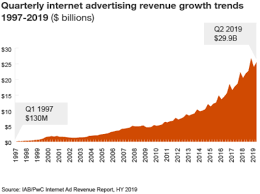 In 2016, Internet advertising revenues in the United States surpassed those of cable television and broadcast television. In 2017, Internet advertising revenues in the United States totaled $83.0 billion, a 14% increase over the $72.50 billion in revenues in 2016.
In 2016, Internet advertising revenues in the United States surpassed those of cable television and broadcast television. In 2017, Internet advertising revenues in the United States totaled $83.0 billion, a 14% increase over the $72.50 billion in revenues in 2016.
Many common online advertising practices are controversial and, as a result, have been increasingly subject to regulation. Online ad revenues also may not adequately replace other publishers’ revenue streams. Declining ad revenue has led some publishers to place their content behind paywalls.
Electronic Mail Advertising
 The first widely publicized example of online advertising was conducted via electronic mail. On 3 May 1978, a marketer from DEC (Digital Equipment Corporation), Gary Thuerk, sent an email to most of the ARPANET’s American west coast users, advertising an open house for a new model of a DEC computer. Despite the prevailing acceptable use policies, electronic mail marketing rapidly expanded and eventually became known as “spam.”
The first widely publicized example of online advertising was conducted via electronic mail. On 3 May 1978, a marketer from DEC (Digital Equipment Corporation), Gary Thuerk, sent an email to most of the ARPANET’s American west coast users, advertising an open house for a new model of a DEC computer. Despite the prevailing acceptable use policies, electronic mail marketing rapidly expanded and eventually became known as “spam.”
The first known large-scale non-commercial spam message was sent on 18 January 1994 by an Andrews University system administrator, by cross-posting a religious message to all USENET newsgroups. In January 1994 Mark Eberra started the first email marketing company for opt in email list under the domain Insideconnect.com. He also started the Direct Email Marketing Association to help stop unwanted email and prevent spam.
Four months later, Laurence Canter and Martha Siegel, partners in a law firm, broadly promoted their legal services in a USENET posting titled “Green Card Lottery – Final One?” Canter and Siegel’s Green Card USENET spam raised the profile of online advertising, stimulating widespread interest in advertising via both Usenet and traditional email. More recently, spam has evolved into a more industrial operation, where spammers use armies of virus-infected computers (botnets) to send spam remotely.
Banner Advertising
Online banner advertising began in the early 1990s as page owners sought additional revenue streams to support their content. Commercial online service Prodigy displayed banners at the bottom of the screen to promote Sears products. The first clickable web ad was sold by Global Network Navigator in 1993 to a Silicon Valley law firm. In 1994, web banner advertising became mainstream when HotWired, the online component of Wired Magazine, and Time Warner’s Pathfinder (website) sold banner ads to AT&T and other companies. The first AT&T ad on HotWired had a 44% click-through rate, and instead of directing clickers to AT&T’s website, the ad linked to an online tour of seven of the world’s most acclaimed art museums.
Search Advertising
 GoTo.com (renamed Overture in 2001, and acquired by Yahoo! in 2003) created the first search advertising keyword auction in 1998. Google launched its “AdWords” (now renamed Google Ads) search advertising program in 2000 and introduced quality-based ranking allocation in 2002, which sorts search advertisements by a combination of bid price and searchers’ likeliness to click on the ads.
GoTo.com (renamed Overture in 2001, and acquired by Yahoo! in 2003) created the first search advertising keyword auction in 1998. Google launched its “AdWords” (now renamed Google Ads) search advertising program in 2000 and introduced quality-based ranking allocation in 2002, which sorts search advertisements by a combination of bid price and searchers’ likeliness to click on the ads.
Editorial Content or Valuable Services Advertising
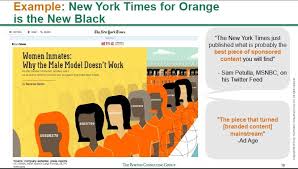 More recently, companies have sought to merge their advertising messages into editorial content or valuable services. Examples include Red Bull’s Red Bull Media House streaming Felix Baumgartner’s jump from space online, Coca-Cola’s online magazines, and Nike’s free applications for performance tracking. Advertisers are also embracing social media and mobile advertising; mobile ad spending has grown 90% each year from 2010 to 2013.
More recently, companies have sought to merge their advertising messages into editorial content or valuable services. Examples include Red Bull’s Red Bull Media House streaming Felix Baumgartner’s jump from space online, Coca-Cola’s online magazines, and Nike’s free applications for performance tracking. Advertisers are also embracing social media and mobile advertising; mobile ad spending has grown 90% each year from 2010 to 2013.
According to Ad Age Datacenter analysis, in 2017 over half of agency revenue came from digital work.
Display Advertising
 Display advertising conveys its advertising message visually using text, logos, animations, videos, photographs, or other graphics. Display advertisers frequently target users with particular traits to increase the ads’ effect. Online advertisers (typically through their ad servers) often use cookies, which are unique identifiers of specific computers, to decide which ads to serve to a particular consumer. Cookies can track whether a user left a page without buying anything, so the advertiser can later retarget the user with ads from the site the user visited.
Display advertising conveys its advertising message visually using text, logos, animations, videos, photographs, or other graphics. Display advertisers frequently target users with particular traits to increase the ads’ effect. Online advertisers (typically through their ad servers) often use cookies, which are unique identifiers of specific computers, to decide which ads to serve to a particular consumer. Cookies can track whether a user left a page without buying anything, so the advertiser can later retarget the user with ads from the site the user visited.
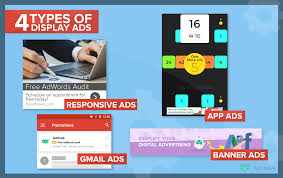 As advertisers collect data across multiple external websites about a user’s online activity, they can create a detailed profile of the user’s interests to deliver even more targeted advertising. This aggregation of data is called behavioral targeting. Advertisers can also target their audience by using contextual to deliver display ads related to the content of the web page where the ads appear. Retargeting, behavioral targeting, and contextual advertising all are designed to increase an advertiser’s return on investment, or ROI, over untargeted ads.
As advertisers collect data across multiple external websites about a user’s online activity, they can create a detailed profile of the user’s interests to deliver even more targeted advertising. This aggregation of data is called behavioral targeting. Advertisers can also target their audience by using contextual to deliver display ads related to the content of the web page where the ads appear. Retargeting, behavioral targeting, and contextual advertising all are designed to increase an advertiser’s return on investment, or ROI, over untargeted ads.
 Advertisers may also deliver ads based on a user’s suspected geography through geotargeting. A user’s IP address communicates some geographic information (at minimum, the user’s country or general region). The geographic information from an IP can be supplemented and refined with other proxies or information to narrow the range of possible locations. For example, with mobile devices, advertisers can sometimes use a phone’s GPS receiver or the location of nearby mobile towers. Cookies and other persistent data on a user’s machine may provide help narrowing a user’s location further.
Advertisers may also deliver ads based on a user’s suspected geography through geotargeting. A user’s IP address communicates some geographic information (at minimum, the user’s country or general region). The geographic information from an IP can be supplemented and refined with other proxies or information to narrow the range of possible locations. For example, with mobile devices, advertisers can sometimes use a phone’s GPS receiver or the location of nearby mobile towers. Cookies and other persistent data on a user’s machine may provide help narrowing a user’s location further.
 Web banners or banner ads typically are graphical ads displayed within a web page. Many banner ads are delivered by a central ad server.
Web banners or banner ads typically are graphical ads displayed within a web page. Many banner ads are delivered by a central ad server.
Banner ads can use rich media to incorporate video, audio, animations, buttons, forms, or other interactive elements using Java applets, HTML5, Adobe Flash, and other programs.
 Frame ads were the first form of web banners. The colloquial usage of “banner ads” often refers to traditional frame ads. Website publishers incorporate frame ads by setting aside a particular space on the web page. The Interactive Advertising Bureau’s Ad Unit Guidelines proposes standardized pixel dimensions for ad units.
Frame ads were the first form of web banners. The colloquial usage of “banner ads” often refers to traditional frame ads. Website publishers incorporate frame ads by setting aside a particular space on the web page. The Interactive Advertising Bureau’s Ad Unit Guidelines proposes standardized pixel dimensions for ad units.
Pop-ups/pop-unders
A pop-up ad is displayed in a new web browser window that opens above a website visitor’s initial browser window. A pop-under ad opens a new browser window under a website visitor’s initial browser window. Pop-under ads and similar technologies are now advised against by online authorities such as Google, who state that they “do not condone this practice”.
Floating ad
 A floating ad, or overlay ad, is a type of rich media advertisement that appears superimposed over the requested website’s content. Floating ads may disappear or become less obtrusive after a pre-set time period.
A floating ad, or overlay ad, is a type of rich media advertisement that appears superimposed over the requested website’s content. Floating ads may disappear or become less obtrusive after a pre-set time period.
Expanding ad
An expanding ad is a rich media frame ad that changes dimensions upon a predefined condition, such as a preset amount of time a visitor spends on a web-page, the user’s click on the ad, or the user’s mouse movement over the ad. Expanding ads allow advertisers to fit more information into a restricted ad space.
 A trick banner is a banner ad where the ad copy imitates some screen element users commonly encounter, such as an operating system message or popular application message, to induce ad clicks. Trick banners typically do not mention the advertiser in the initial ad, and thus they are a form of bait-and-switch. Trick banners commonly attract a higher-than-average click-through rate, but tricked users may resent the advertiser for deceiving them.
A trick banner is a banner ad where the ad copy imitates some screen element users commonly encounter, such as an operating system message or popular application message, to induce ad clicks. Trick banners typically do not mention the advertiser in the initial ad, and thus they are a form of bait-and-switch. Trick banners commonly attract a higher-than-average click-through rate, but tricked users may resent the advertiser for deceiving them.
News Feed Ads
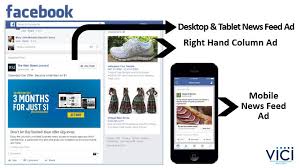 “News Feed Ads”, also called “Sponsored Stories”, “Boosted Posts”, typically exist on social media platforms that offer a steady stream of information updates (“news feed”) in regulated formats (i.e. in similar sized small boxes with a uniform style). Those advertisements are intertwined with non-promoted news that the users are reading through. Those advertisements can be of any content, such as promoting a website, a fan page, an app, or a product.
“News Feed Ads”, also called “Sponsored Stories”, “Boosted Posts”, typically exist on social media platforms that offer a steady stream of information updates (“news feed”) in regulated formats (i.e. in similar sized small boxes with a uniform style). Those advertisements are intertwined with non-promoted news that the users are reading through. Those advertisements can be of any content, such as promoting a website, a fan page, an app, or a product.
Some examples are: Facebook’s “Sponsored Stories”, LinkedIn’s “Sponsored Updates”, and Twitter’s “Promoted Tweets”.
This display ads format falls into its own category because unlike banner ads which are quite distinguishable, News Feed Ads’ format blends well into non-paid news updates. This format of online advertisement yields much higher click-through rates than traditional display ads.
Display advertising process overview
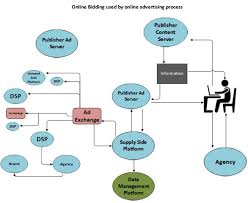 The process by which online advertising is displayed can involve many parties. In the simplest case, the website publisher selects and serves the ads. Publishers which operate their own advertising departments may use this method.
The process by which online advertising is displayed can involve many parties. In the simplest case, the website publisher selects and serves the ads. Publishers which operate their own advertising departments may use this method.
The ads may be outsourced to an advertising agency under contract with the publisher, and served from the advertising agency’s servers.
Alternatively, ad space may be offered for sale in a bidding market using an ad exchange and real-time bidding. This involves many parties interacting automatically in real time. In response to a request from the user’s browser, the publisher content server sends the web page content to the user’s browser over the Internet. The page does not yet contain ads, but contains links which cause the user’s browser to connect to the publisher ad server to request that the spaces left for ads be filled in with ads. Information identifying the user, such as cookies and the page being viewed, is transmitted to the publisher ad server.
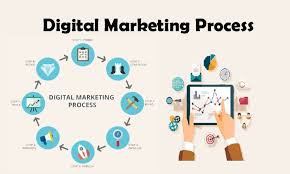 The publisher ad server then communicates with a supply-side platform server. The publisher is offering ad space for sale, so they are considered the supplier. The supply side platform also receives the user’s identifying information, which it sends to a data management platform. At the data management platform, the user’s identifying information is used to look up demographic information, previous purchases, and other information of interest to advertisers.
The publisher ad server then communicates with a supply-side platform server. The publisher is offering ad space for sale, so they are considered the supplier. The supply side platform also receives the user’s identifying information, which it sends to a data management platform. At the data management platform, the user’s identifying information is used to look up demographic information, previous purchases, and other information of interest to advertisers.
Broadly speaking, there are three types of data obtained through such a data management platform:
- First party data refers to the data retrieved from customer relationship management (CRM) platforms, in addition to website and paid media content or cross-platform data. This can include data from customer behaviors, actions or interests.
- Second party data refers to an amalgamation of statistics related to cookie pools on external publications and platforms. The data is provided directly from the source (ad-servers, hosted solutions for social or an analytics platform). It is also possible to negotiate a deal with a particular publisher to secure specific data points or audiences.
- Third party data is sourced from external providers and often aggregated from numerous websites. Businesses sell third-party data and are able to share this via an array of distribution avenues.
This customer information is combined and returned to the supply side platform, which can now package up the offer of ad space along with information about the user who will view it. The supply side platform sends that offer to an ad exchange.
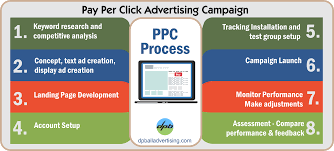 The ad exchange puts the offer out for bid to demand-side platforms. Demand side platforms act on behalf of ad agencies, who sell ads which advertise brands. Demand side platforms thus have ads ready to display, and are searching for users to view them. Bidders get the information about the user ready to view the ad, and decide, based on that information, how much to offer to buy the ad space. According to the Internet Advertising Bureau, a demand side platform has 10 milliseconds to respond to an offer. The ad exchange picks the winning bid and informs both parties.
The ad exchange puts the offer out for bid to demand-side platforms. Demand side platforms act on behalf of ad agencies, who sell ads which advertise brands. Demand side platforms thus have ads ready to display, and are searching for users to view them. Bidders get the information about the user ready to view the ad, and decide, based on that information, how much to offer to buy the ad space. According to the Internet Advertising Bureau, a demand side platform has 10 milliseconds to respond to an offer. The ad exchange picks the winning bid and informs both parties.
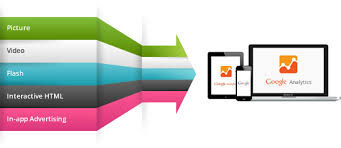 The ad exchange then passes the link to the ad back through the supply side platform and the publisher’s ad server to the user’s browser, which then requests the ad content from the agency’s ad server. The ad agency can thus confirm that the ad was delivered to the browser.
The ad exchange then passes the link to the ad back through the supply side platform and the publisher’s ad server to the user’s browser, which then requests the ad content from the agency’s ad server. The ad agency can thus confirm that the ad was delivered to the browser.
This is simplified, according to the IAB. Exchanges may try to unload unsold (“remnant”) space at low prices through other exchanges. Some agencies maintain semi-permanent pre-cached bids with ad exchanges, and those may be examined before going out to additional demand side platforms for bids. The process for mobile advertising is different and may involve mobile carriers and handset software manufacturers.
Interruption Marketing
An interstitial ad displays before a user can access requested content, sometimes while the user is waiting for the content to load. Interstitial ads are a form of interruption marketing.
Text ads
A text ad displays text-based hyperlinks. Text-based ads may display separately from a web page’s primary content, or they can be embedded by hyperlinking individual words or phrases to the advertiser’s websites. Text ads may also be delivered through email marketing or text message marketing. Text-based ads often render faster than graphical ads and can be harder for ad-blocking software to block.
I hope that you have really enjoyed this post, you might also be interested in other information which can be found in JMJ45TECH’s ONLINE STORE.
Please Leave All Comments in the Comment Box Below ↓
Lenovo-N23-Yoga-Touchscreen-2-in-1-Chromebook-11-6-MT8173c-4GB-RAM-32GB-eMMC









Hi Jerry,
I appreciate you have listed all the ways we could possibly advertise online these days. I’m getting started in online marketing and this has been an educational post for me.
I used to see a lot of trick banners some years ago but not anymore. Probably users started to react unfavorably towards these types of ads.
Hello,
It is my pleasure to educate, train, inform people in a way that I feel things can become easily receptive. I want to be able to connect with people on every level. Thank you so much for your comments, and more importantly, for receiving the information at hand.
I Hope For Many Blessings For You My Friend!
I really enjoyed reading and learning a lot from your article ‘Internet Marketing’.
I think online marketing is a really great way to earn a steady or alternative source of income. There are many platforms out there that offer a host of services and benefits which one can choose from and its also important to have more than one source of income.
Hey Beesean,
I absolutely agree!
Please Have A Blessed And Enjoyable Day!
This has been a very informative and well researched post on Internet Marketing and all the different types of advertising. I never knew the history behind it all and that there are so many different options available to the advertiser to use when promoting their products. Some banners and pop-up can be annoying, but one can see why advertisers would use them, as they do grab the attention.
And of course it can also provide one with a different stream of income.
Hello, I hope all is well,
Great insight —-, Thank you for your feedback.
Stay Blessed and Stay Safe!
I really enjoyed reading your article of the different forms of online advertising.
I am sure that as an internet user, I have experienced most of those types of advertising. I can say that some of them are among my least favorite when I come across them. Especially pop ups or interruption ads.
I will definitely be back to your site to learn more about internet marketing.
Thank you for a thorough and informative article.
Hello,
Thank you for commenting and enjoying reading about Internet Marketing.
I must agree that pop ups or interruption ads can be a bit tedious. Thank you for a planned return to this site, as you are welcome to return anytime.
Thanks again for commenting.
Blessings My Friend,
Jerry
Very informative site.
It’s obviously important to understand your business goals to determine what advertising platform and avenue to use. Certainly making sure the website platform can handle certain advertising advantages.
Cost is also a big factor with these goals. I enjoyed how you broke each area down to understand the complexity of each avenue of internet marketing. Internet is where it’s at.
As a Realtor, without the internet, I’m doing ZERO business. I also like your Affiliate Disclaimer.
I haven’t seen that much on affiliate based sites.
Hello,
Thank you for stopping by and considering this a very informative site.
I definitely agree that price is a very real issue in internet marketing, especially when trying to decide which services are best for whichever direction you are trying to take your brand.
There are so many directions for the same results available these days.
Thanks again for your interest.
Blessings,
Jerry